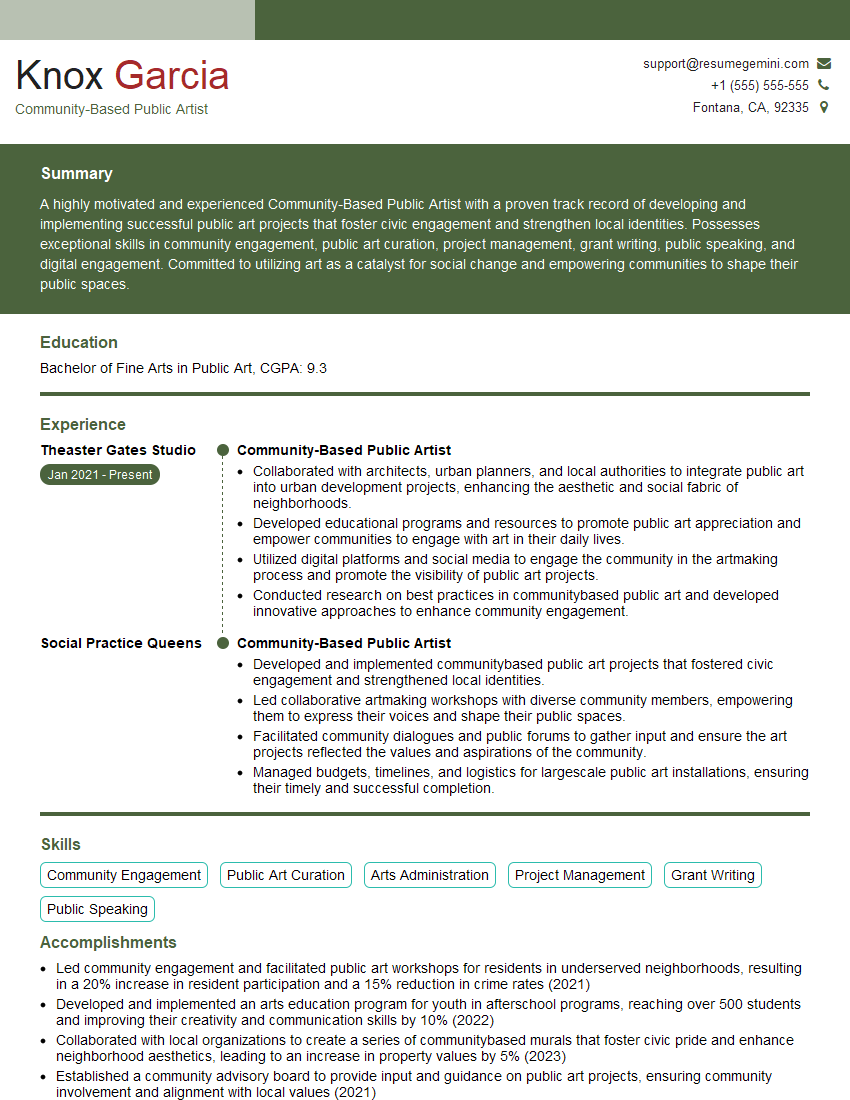Are you gearing up for a career shift or aiming to ace your next interview? Look no further! We’ve curated a comprehensive guide to help you crack the interview for the coveted Community-Based Public Artist position. From understanding the key responsibilities to mastering the most commonly asked questions, this blog has you covered. So, buckle up and let’s embark on this journey together
Acing the interview is crucial, but landing one requires a compelling resume that gets you noticed. Crafting a professional document that highlights your skills and experience is the first step toward interview success. ResumeGemini can help you build a standout resume that gets you called in for that dream job.
Essential Interview Questions For Community-Based Public Artist
1. Can you give an overview of your experience as a community-based public artist?
As a community-based public artist with over 5 years of experience, I specialize in engaging communities in participatory art projects that foster dialogue, promote social justice, and create a sense of belonging. I’ve successfully completed several large-scale public art installations that have had a positive impact on their communities.
2. How do you approach the process of creating community-based public art?
Community Engagement and Collaboration
- Initiate dialogue and build relationships with community members.
- Identify shared interests, concerns, and aspirations through participatory workshops and conversations.
Concept Development and Visioning
- Develop artistic concepts that resonate with the community’s input and align with their values.
- Facilitate brainstorming and ideation sessions to encourage collective ownership of the project.
3. What is your experience in working with diverse communities and addressing issues of equity and inclusion?
- Collaborated with marginalized communities to amplify their voices and empower them through art.
- Developed projects that explore themes of identity, representation, and social justice to promote understanding and empathy.
- Created accessible and inclusive art experiences for individuals with different abilities and backgrounds.
4. Describe a successful public art project you have led that involved community participation.
- Led a collaborative mural project with a youth organization to address issues of youth empowerment and neighborhood safety.
- Facilitated a participatory art installation in a community garden, engaging residents in creating a collective space for reflection and connection.
5. How do you evaluate the impact of your public art projects?
- Conduct post-project assessments to gather feedback from community members and stakeholders.
- Measure outcomes based on defined goals, such as increased civic engagement, improved neighborhood aesthetics, or enhanced community identity.
- Track the longevity and sustainability of the artwork and its impact over time.
6. What are your thoughts on the role of public art in urban revitalization?
Public art plays a vital role in urban revitalization by transforming public spaces into vibrant, inclusive, and welcoming places. It can stimulate economic growth, attract tourism, and strengthen community bonds. By engaging residents in the creation process, public art projects can create a sense of ownership and empower communities to shape their environment.
7. How do you stay updated on contemporary art practices and trends in community-based public art?
- Attend conferences, workshops, and exhibitions to connect with other artists and learn about innovative approaches.
- Read books, articles, and online resources to stay informed about emerging theories and methodologies.
- Participate in professional development programs and research projects to enhance my knowledge and skills.
8. Describe your experience in fundraising and managing budgets for public art projects.
- Developed successful grant proposals to secure funding for community-based art projects.
- Managed budgets effectively, ensuring timely completion of projects within financial constraints.
- Collaborated with community organizations and businesses to secure in-kind support and resources.
9. How do you handle challenging situations that may arise during the implementation of a public art project?
- Maintain clear and open communication with all stakeholders to address concerns and resolve issues promptly.
- Facilitate dialogue and compromise to find mutually acceptable solutions.
- Seek guidance from project partners, advisory boards, or legal counsel when necessary to navigate complex situations.
10. What are your aspirations for your future as a community-based public artist?
- Continue to create impactful and transformative art projects that engage communities and promote social change.
- Expand my artistic practice to explore new mediums and technologies.
- Mentor emerging artists and support the development of community-based public art initiatives.
Interviewers often ask about specific skills and experiences. With ResumeGemini‘s customizable templates, you can tailor your resume to showcase the skills most relevant to the position, making a powerful first impression. Also check out Resume Template specially tailored for Community-Based Public Artist.
Career Expert Tips:
- Ace those interviews! Prepare effectively by reviewing the Top 50 Most Common Interview Questions on ResumeGemini.
- Navigate your job search with confidence! Explore a wide range of Career Tips on ResumeGemini. Learn about common challenges and recommendations to overcome them.
- Craft the perfect resume! Master the Art of Resume Writing with ResumeGemini’s guide. Showcase your unique qualifications and achievements effectively.
- Great Savings With New Year Deals and Discounts! In 2025, boost your job search and build your dream resume with ResumeGemini’s ATS optimized templates.
Researching the company and tailoring your answers is essential. Once you have a clear understanding of the Community-Based Public Artist‘s requirements, you can use ResumeGemini to adjust your resume to perfectly match the job description.
Next Step:
Armed with this knowledge, you’re now well-equipped to tackle the Community-Based Public Artist interview with confidence. Remember, preparation is key. So, start crafting your resume, highlighting your relevant skills and experiences. Don’t be afraid to tailor your application to each specific job posting. With the right approach and a bit of practice, you’ll be well on your way to landing your dream job. Build your resume now from scratch or optimize your existing resume with ResumeGemini. Wish you luck in your career journey!
